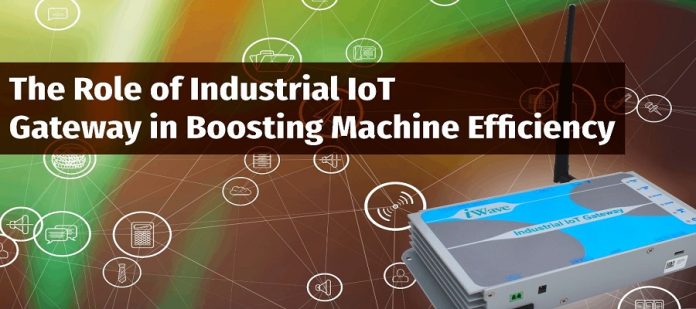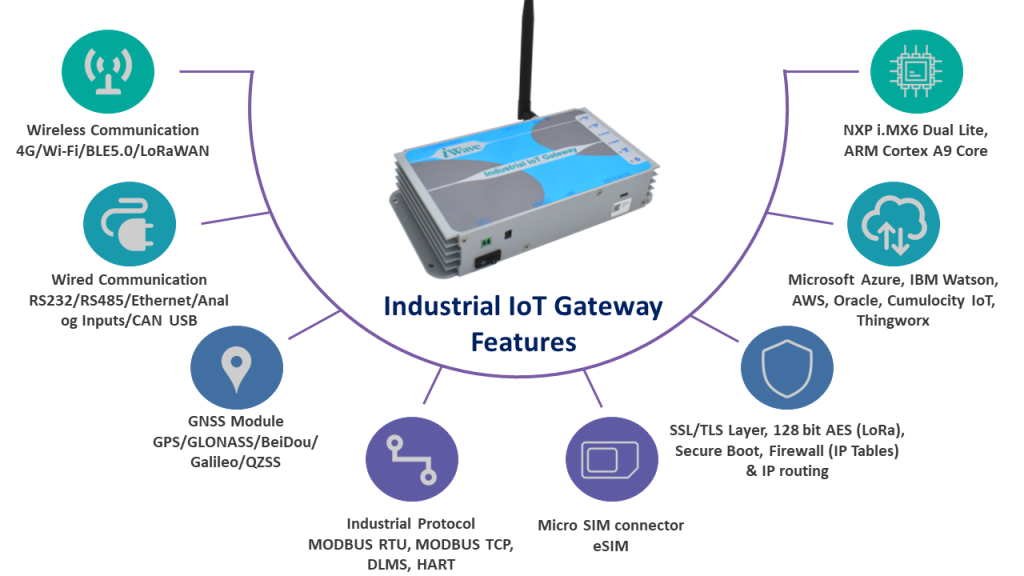In today’s rapidly evolving industrial landscape, the convergence of physical machinery and digital technologies has given rise to the Industrial Internet of Things (IIoT). At the heart of this transformative wave lies the IIoT gateway, a critical component that acts as a bridge connecting the physical world of industrial devices and machinery with the digital realm of the internet.
The Industrial IoT Gateway acts as a communication hub between sensors and servers, collecting sensor data and transmitting relevant information to the cloud. By harnessing the power of connectivity, protocol translation, edge computing, and robust security measures, these gateways pave the way for enhanced operational efficiency, predictive maintenance, and accelerated industrial digital transformation.
The iWave Industrial IoT gateway is a powerful and versatile device that can be used to collect, process, and transmit data from a wide range of industrial sensors and devices. The gateway is based on a high-performance ARM Cortex A9 processor and supports a variety of wired and wireless connectivity options enabling seamless communication across the network.
iWave’s Industrial IoT Gateway Features
- Connectivity: The gateway supports a wide range of wireless connectivity options, including 4G LTE, LoRaWAN, Wi-Fi, and Bluetooth. This allows it to connect to a variety of industrial devices and sensors.
- Security: The gateway is designed to be secure and reliable. It includes a number of security features, such as TSL/SSL certifications, secure boot, 128-bit AES (LoRa) encrypt/decrypt, and authentication, to protect data from unauthorized access or tampering. It also features a watchdog timer to prevent the gateway from crashing.
- Powerful processor: The gateway is powered by a powerful ARM Cortex A9 processor, which provides the performance needed to run demanding industrial applications.
- Interfaces: The gateway supports a wide range of industrial interfaces, including Ethernet, USB, CAN, RS232, RS485, Analog Inputs, and Digital Inputs. This allows it to connect to a wide range of industrial equipment.
- Industrial Protocols: The gateway supports a wide range of industrial protocols, including MODBUS RTU/TCP, DLMS, HART, and PROFINET. This allows it to communicate with a wide range of industrial devices and systems.
- Cloud connectivity: The gateway can connect to the cloud, allowing it to send data to and receive commands from cloud-based applications. iWave IoT Gateway supports a wide range of cloud platforms such as Microsoft Azure, IBM Watson, AWS, Oracle, Cumulocity IoT, and Thingworx.
- Uninterrupted High-Accuracy Vehicle Location: High-precision GNSS (Global Navigation Satellite System) Module – GPS/GLONASS/BeiDou/Galileo
- System recovery and crash handling: Industrial IoT Gateway uses external watchdog timers to support the emergency safe shutdown and auto reboot logic to ensure that the gateway remains operational even in the event of a crash.
- Remote management: The gateway can be remotely managed, allowing administrators to configure and monitor the gateway from anywhere.
- Scalability: The gateway is built on a modular architecture that allows IoT sensors to be scaled-up or scaled down to meet the needs of any application. It can be easily expanded by adding additional modules, such as wireless connectivity, interface, and storage modules.
Industrial IoT Gateway and How to Pick the Right Fit
When choosing an IIoT Gateway, various key factors should be considered.
- Hardware modularity
- Software flexibility
- Security and connectivity options available on the module
Industrial IoT Gateways Use Cases and Deployment Options
Let’s look at a few real-world case studies to better understand the challenges of building industrial IoT gateways.
Factory Automation
Industrial IoT Gateways facilitate the communication between tens and thousands of IoT devices, machinery, sensors, and factory equipment, as well as communication between these devices and the cloud. They enable remote monitoring of factory assets and control of such assets.
Smart Manufacturing
The IIoT gateway enables real-time monitoring of PLCs, provides remote access for diagnostics and troubleshooting, offers data visualization and analytics, and allows for integration with higher-level manufacturing systems. It enhances the efficiency, visibility, and control of PLC operations, enabling proactive maintenance, optimization, and decision-making in manufacturing plants.
Smart Energy Consumption Monitoring
In industrial settings, IIoT Gateway can be used to regularly monitor and manage energy consumed by machines. Sensors, meters, and other IoT devices can be used to track how much energy each piece of equipment consumes. As a result, strategic actions can be taken to subdue the consumption of electricity and boost the overall efficiency of a facility by collecting energy utilization parameters.
Enterprise IIoT
An IIoT gateway for enterprise applications acts as a communication hub, connecting operational technology devices to the information technology infrastructure. It collects and transmits data from various devices, performs protocol translation, enables edge computing for faster insights, ensures data security, and facilitates integration with higher-level systems. The IIoT gateway streamlines data flow, enhances operational efficiency, and enables real-time monitoring and decision-making in enterprise environments.
Transformers
IoT gateways play a vital role in changing traditional transformers into intelligent, connected assets. They enable remote monitoring, diagnostics, predictive maintenance, fault detection, and easy integration with broad grid management systems. Sensors installed in transformers are used to collect real-time data such as temperature, oil levels, vibration, and electrical parameters to enable proactive maintenance.
Connecting IoT devices securely to the cloud and gathering data from them can be daunting, but it does not have to be. With features like remote management, network mapping, security options, and more, IoT Gateways provide an easier way to connect and manage everything from data security and connectivity protocol to edge computing.



